Q surprised me in the field by walking the last 20 feet or so to meet me – I really
think we had some kind of crazy break-through in NC, her trust in me has really
taken a leap forward. I pulled her from the field, tacked her up, and we headed
out.
I always note when I bring her in if she has any filling in her legs
anywhere. She tends to get a little filling if she’s been standing in the same
place while and always if she’s been stalled or high-lined (unless it’s the morning
after a big ride, then she tends to not have as much filling). I always
double-check her legs for heat/tenderness when there is filling just to be
certain it isn’t masking some other issue. Days like Sunday where she comes in
without any filling though, I just do a visual check and not hands-on. Also, it’s
rare that I lunge her pre-ride, too, unless she is being very fresh with me.
These practices – especially the lunging – are going to change.
I noticed as
we headed out that she wasn’t as forward as she usually is. No big, I’d prefer
to leave the immediate property at a walk anyway. But then she was being very evasive
of the large gravel area (like softball sized stones, not quarter-sized). She
usually isn’t bothered by this area or overly evasive of it. I asked her to
walk on it and she did, but she moved off as soon as she could. Her strides
were a tiny bit shorter than usual, too. I asked her to walk on it again and
watched her footfalls. Still heel first landings, just more tentative in these.
It is important to note that I doubt another person riding her would have
noticed any issue in her movement. I only notice because I ride her so much and
am so attuned to her.
We crossed the creek and the larger, flatter rocks
there without any issues. As we started to head up the soft clay/minute rock
surfaced ATV trail on the other side I asked her to trot. Her trot was less
forward, and as with the rest of her movement thus far it was more
short-strided. And…she had the slightest bobble of the head in harmony with her
right foreleg.
Damnit.
I brought her back to a walk and got VERY
hyper-sensitive about all of her movements. I felt for the slightest bobble anywhere.
I had to reign myself in because I was getting a little uppity about a lot of
nonsense that didn’t exist.
When we got to the gravel road (which is
basically just a hard clay surface since the gravel has been plowed away this
winter) I hopped off and picked up her feet looking for some sort of clue. I
felt her legs for heat and her digital pulse to see if that was bumpin’.
Nothing out of the norm. Nothing.
I hopped back on and had her trot again on
the road. Slight bobble. Slight offness.
Damnit.
Back to a walk. Back to
hyper-assessment. Yep, slightest bit of
offness. I dismounted, hooked her reins to her halter and had her trot a tiny
circle around me. Yep. Definitely off on the right fore.
Damnit.
I walked
her back up the road toward home. I assessed her movement as we went. All heel
first landings, stride the slightest bit shorter than normal. No visible
offness at a walk with me on the ground. She chose to walk both on the berm and
on the road as we walked the third-of-a-mile to the woods.
The day’s plan
was wasted, but the day was not wasted. I cleared the short stretch of trail of
branches and limbs as we went along. SUCH an improvement and SO MUCH MORE to
do.
: : : : :
Back at the barn I untacked Q, picked out her feet, and decided to cut/pull
off the remaining frog that she hadn’t shed off yet. When her frogs started shedding about a month ago it freaked me out a lot. She had such a huge beautiful frog on her fronts over the summer, and it really freaked me out that it would just sheer off the way it seemed to be doing. I had read a lot about how to not bother them when they did this and to just let things take their natural course. I'd always done this before with smaller pieces, so I sucked it up and let it do its thing.
She was slightly off on the right fore one time about a month ago when I discovered that her frogs seemed to be shedding. It was the same slight offness that it was on this day that was most noticeable with a rider at a trot and nearly went away when the rider dismounted (I was giving a mini-lesson on her), and was almost entirely gone when she was untacked, with Renegades on, trotting around the ring. (In fact at that point it could have been argued that the tiny blippit (tiniest!) in her gait was just because she thought there should be pain when there wasn't.
It irked me a little to take off the last little bit of frog (the last inch right at the apex was the remaining part - everything else had already shed off during the NC weekend and immediately after), but I was worried about two things which spurred me to do it: 1.) that perhaps her issue was a tiny rock or something of the like getting stuck under the flap while we were moving along and causing her a little grief, 2.) that there was some sort of fungus in there because it was pretty messy and the end of the flap (far away from what was still connected) was discolored and smelled awful. I questioned myself for removing the flaps (A LOT), but she’d already shed off 4/5 of her frog on her own and these pieces were close. I was as conservative as I could be with the removal, just pulling/cutting through the last little bit as high up as possible - not cutting down and into her foot at all!
She was slightly off on the right fore one time about a month ago when I discovered that her frogs seemed to be shedding. It was the same slight offness that it was on this day that was most noticeable with a rider at a trot and nearly went away when the rider dismounted (I was giving a mini-lesson on her), and was almost entirely gone when she was untacked, with Renegades on, trotting around the ring. (In fact at that point it could have been argued that the tiny blippit (tiniest!) in her gait was just because she thought there should be pain when there wasn't.
It irked me a little to take off the last little bit of frog (the last inch right at the apex was the remaining part - everything else had already shed off during the NC weekend and immediately after), but I was worried about two things which spurred me to do it: 1.) that perhaps her issue was a tiny rock or something of the like getting stuck under the flap while we were moving along and causing her a little grief, 2.) that there was some sort of fungus in there because it was pretty messy and the end of the flap (far away from what was still connected) was discolored and smelled awful. I questioned myself for removing the flaps (A LOT), but she’d already shed off 4/5 of her frog on her own and these pieces were close. I was as conservative as I could be with the removal, just pulling/cutting through the last little bit as high up as possible - not cutting down and into her foot at all!
The furthest end of the flap, the freest end,
was black and smelled bad. BAD. Upon removal though, I found that the rest of the piece was fine - whew. I
presume this was just normal tissue decay on the far end - this area was nowhere near her hoof
where live(ish) frog still exists/existed/was shedding.
I was a little
concerned about bacteria and thrush because her central sulcus isn’t as “open”
as it was earlier in the year. Photos even confirm that just a few months ago
it was more open than it is now (right front in January and same foot in February). Photos also confirm that this change in her
frogs has been going on steadily as the winter has remained wet. The pock-marking on her soles has never entirely gone away in the time I've had her either - though I do think her feet have improved in this time, once again evident in the photos.
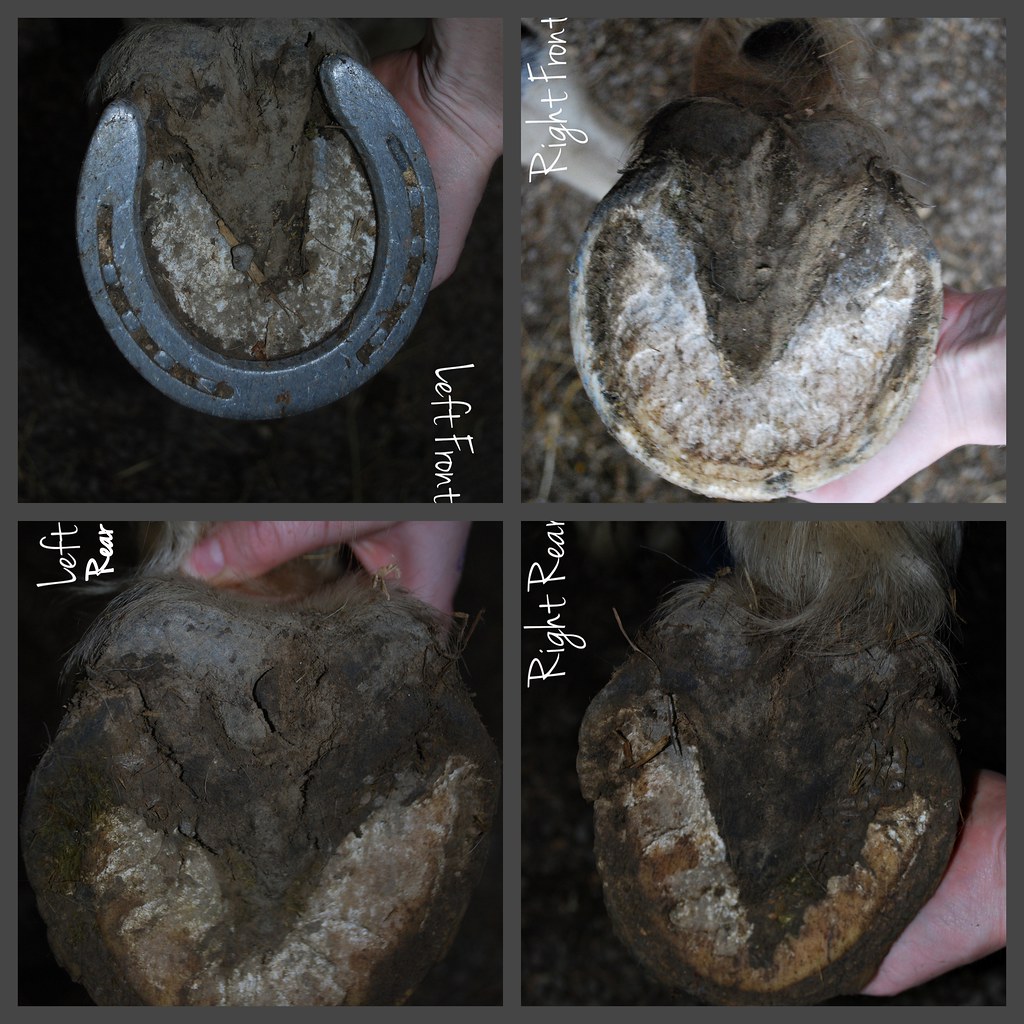 |
| June, right after I got her |
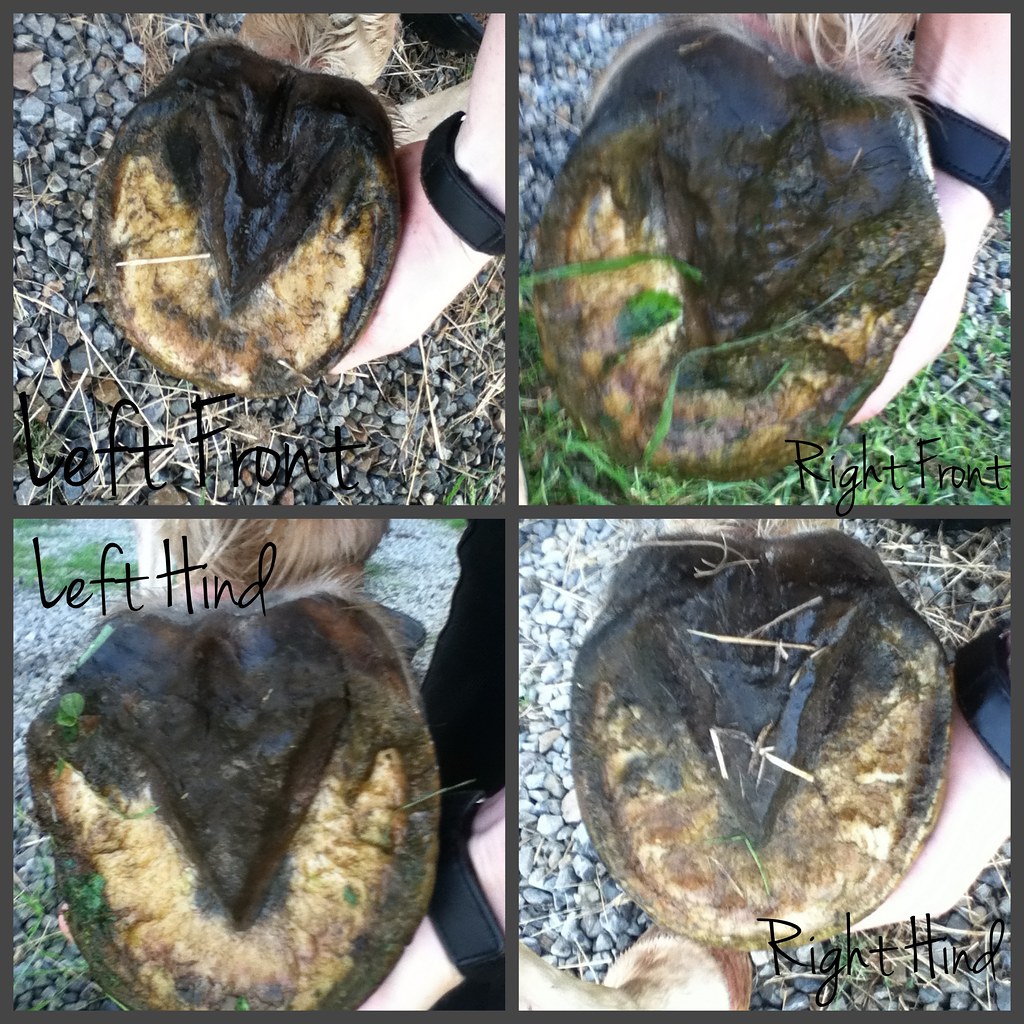 |
| September 2012 |
I decided I’d soak both her front feet
with White Lightning since I
suddenly had so much time on my hands. …and I was sort of worried something
crazy was going on/I’d done something horribly wrong in pulling off those
remaining flaps.
Q was a superstar about the soaking bag. Two other horses
were in the barn for moral support. A pregnant (baby will be here soon!!) mare
and Griffin. I stood with Q/sat in a chair beside her the whole 90 minutes (45
min/hoof) and flipped through my 101 Dressage Exercises book and rubbed on her.
She had hay (all of them did), but she worked on it intermittently. She looked
around a lot, but with the first soak she didn’t move the foot that was being
treated AT ALL. She moved all her other feet around but left that one planted.
The second hoof she did walk around a bit. She was startled, but I stuck right
with her and talked to her the whole time so she wouldn’t spazz. She didn’t like it by any means, but she wasn’t
freaked. Good mare.
I turned her out afterwards after rewarding her with an
apple and booked it home to consult with others about what I’d done/seen in her
feet.
: : : : :
I spent that evening shooting questions out and discussing the “frogs
shed, myth or fact” with a few people (thank you!). And then I spent hours on Pete Ramey’s site reading through his articles confirming and cementing
things I already knew, while embracing and pondering other concepts I wasn’t as
certain about.
Learning about hoof care is a process. The knowledge is
constantly evolving. It’s hard to take in so much at once, so I tend to learn a
ton in bursts as things crop up that concern me. Trying to force knowledge down
my throat when I’m not on a mission like I was recently ends up in me zoning
out and not gaining much from the information.
Here’s what I cemented into my
mind from Mr. Ramey on this burst of knowledge-gathering:
His article on frog management immediately assuaged some of my anxiety about what I'd done with the flaps. Just think before you cut! There is no such thing as a “good
habit”. I'd definitely thought about what I was doing. I definitely waxed and waned over it. And then he pointed out four reasons for frog trimming (beneficial in green, detrimental in red): The removal of “flaps” that harbor destructive fungus and bacteria.
The removal of external callusing that protects the frog from
destructive fungus and bacteria. The removal of excess frog height/pressure that can cause sensitivity.The thinning of the frog’s protective barrier between the sensitive
corium and the terrain can overexpose nerves to pressure (cause bruising and lameness). For me, seeing that little bit of decaying tissue and not knowing what was going on with that was what ultimately pushed me to my decision because the other pieces hadn't done that. So that was a potentially beneficial decision. However, upon removal - seeing that fungus wasn't everywhere - it was me thinning a protective barrier, so that was detrimental. So one potential positive and one probable negative.
This article discussed how there isn’t one hoof for all seasons. Feet change with the seasons and with the terrain they’re presented with. A barefoot horse working on an asphalt road (i.e., carriage horse) or living in a field that is frozen solid in winter or that is parched to a hard dry surface in the summer (the central theme here is a hard surface) will have less concavity to their foot than a horse on softer terrain types. If you try to trim the foot of a horse on a hard surface into a concave hoof, it will result in more bad than good. A horse’s hoof will alter to the terrain it is on. If the field is wet and soft in the winter, but dry and hard in the summer you’ll see their feet change to adapt.
This article discussed how there isn’t one hoof for all seasons. Feet change with the seasons and with the terrain they’re presented with. A barefoot horse working on an asphalt road (i.e., carriage horse) or living in a field that is frozen solid in winter or that is parched to a hard dry surface in the summer (the central theme here is a hard surface) will have less concavity to their foot than a horse on softer terrain types. If you try to trim the foot of a horse on a hard surface into a concave hoof, it will result in more bad than good. A horse’s hoof will alter to the terrain it is on. If the field is wet and soft in the winter, but dry and hard in the summer you’ll see their feet change to adapt.
Another article on understanding the sole noted that you should
consider the thickness of the sole first before trimming. Trimming to much in
the toe or heel and taking away sole thickness that you shouldn’t have removed
will be detrimental to the hoof/horse. Additionally, a horse that is moving correctly
will wear his hooves evenly.
Mayer has awful, awful cracks in her front feet
that present like the hooves in the last set of photos in this article on wall cracks. Mr. Ramey noted that crack such as
these almost always have fungus as a culprit and should be frequently soaked in
addition to a good trimming protocol in order to properly “grow out” the
cracks. He also noted that for cracks that “won’t grow out” fungus is usually
the culprit. You’ve got to create an environment that is hostile to fungus but
not to living tissue so the hoof can combat it – this is not always easy!
I
gleaned a lot of information from his article on heel height. I was surprised with how many notes I took as I read
this article. Before I share my notes and what I learned, I wanted to point out
that Pete remarks that he now requires
owners who request him to pull shoes from horses [presumably horses that are
worked and ridden frequently and have unhealthy feet] to buy boots. He will then buy those used boots
from the people 4-6 months later. I think this is brilliant. I’ve experienced first-hand and heard many stories about
people wanting to switch barefoot and then presuming that their horses will
have great feet immediately. No. Just
no. It is a process. From my
experiences, I’ve seen people give up on barefoot just as quickly as they
started because they don’t realize this! I love that Pete requires another form
of hoof protection for the transition period. I’d be willing to bet he has a
greater percentage of successful switch-overs as a result.
Now for what I gleaned
from this article – “...sole bruising and
corium crushing are myths! …brought about by unhealthy hooves and routine sole
trimming…”. I agree. Definitely agree. Another great point? The mechanics
of a hoof in motion > mechanics of a hoof on concrete. He pointed out that just
looking at the way a hoof is when standing on a hard, level surface (i.e., the
wash rack) isn’t representative of how well that hoof performs when it is
working. “The mechanics of impact are
much more important than the mechanics of standing around.” Amen. What you
see as no pressure on concrete may be AWESOME pressure on working terrain. Basically,
don’t go trimming like an idiot without observing the horse in motion to see
how they move and utilize what they have. Not all horses are the same, and thus
not all horses move the same and grow the same hoof. Similar? Probably. Same?
Nah.
For me with Q and her [re]developing frog right now, this translates to
me not touching her heels much for a little bit. She needs the little extra
that is back there to protect the “new” area. If I took off too much heel right
now to encourage heel first landings to stimulate her frog which is really
tender right now since it is changing, she’d likely convert to a toe first
landing to protect the tender area. This wouldn’t help the strengthening of the
back of her foot at all!
I plan to work her on surfaces she can move out on
like normal or boot her for a few weeks to help her build up again. It wouldn’t
be fair at all to expect her to go crunch rocks like she was. A little longer
heel right now will provide some protection on hard surfaces, but as long as
she is moving naturally with her heel first landing in softer terrain she’ll
still gain stimulation at the back of her foot as her heels sink into the
ground a little. Natural movement forges
a natural hoof. Trimming for a
natural hoof shape will cause sensitivity!
Pete notes at the end of this
article how his “experiments” with heel height taught him [once again] that
doing less (i.e., trimming less) benefited more in the end. He noted that heels
naturally ended up lower than he’d ever have dreamed of trimming them. This is
a perfect representation of Q’s feet. I barely touch the heels on her hind
feet. I bring her toes back and maintain the little flare she gets medially back
there, but her heels? Aw naw. (10 points to anyone who gets that song
reference.) And as a result her heels are lower than I’d ever dream of trimming
them. But look at this foot! That frog!
: : : : :
In a follow-up visit Monday, Q was no worse or better. And I honestly don't believe that the small piece I removed made her any *worse* feeling than she was. She's still tender, but she didn't strike us (BO and another boarder) as miserable. BO pointed out that when she walks it isn't with great hesitation or anything. She's got rhythm to her movement, she's just a little ouchy. It still kills me to see her not move soundly. She hasn't moved like this since I've had her and it just kills me. (See video below...and yes, I could have removed the ambient noise in the video but it cracked me up. The round pen is right beside the aviary with the hens, roosters, and peacocks. BO and other boarder were in their observing how one rooster will attack the other boarder but not BO, and then the peacocks were going bonkers.)
I didn't put boots on her Monday night to see if that made a difference, nor did I buff up her toes as I'd hoped to. I did get some photos of her feet though. I was blown away by the medio-lateral "offness" in her feet. But it directly correlates to the way she moves (I'll have to get a better video of that sometime.) Reasoning for not doing these things that night was because the pregnant (about to drop!) mare was in the indoor round pen and Q's boyfriend was pitching a royal fit outside without Q for once. She was being better than usual about it, but was still antsy. Mares! Sigh.
Conclusion? I need to see how comfortably she moves in boots/boots with pads. It kills me to see her move like she does, but while tender, she doesn't seem miserable. She's still willing to play in the field with the others and move out - fast. Time is my friend, so we'll see how she feels in upcoming days and weeks!
I didn't put boots on her Monday night to see if that made a difference, nor did I buff up her toes as I'd hoped to. I did get some photos of her feet though. I was blown away by the medio-lateral "offness" in her feet. But it directly correlates to the way she moves (I'll have to get a better video of that sometime.) Reasoning for not doing these things that night was because the pregnant (about to drop!) mare was in the indoor round pen and Q's boyfriend was pitching a royal fit outside without Q for once. She was being better than usual about it, but was still antsy. Mares! Sigh.
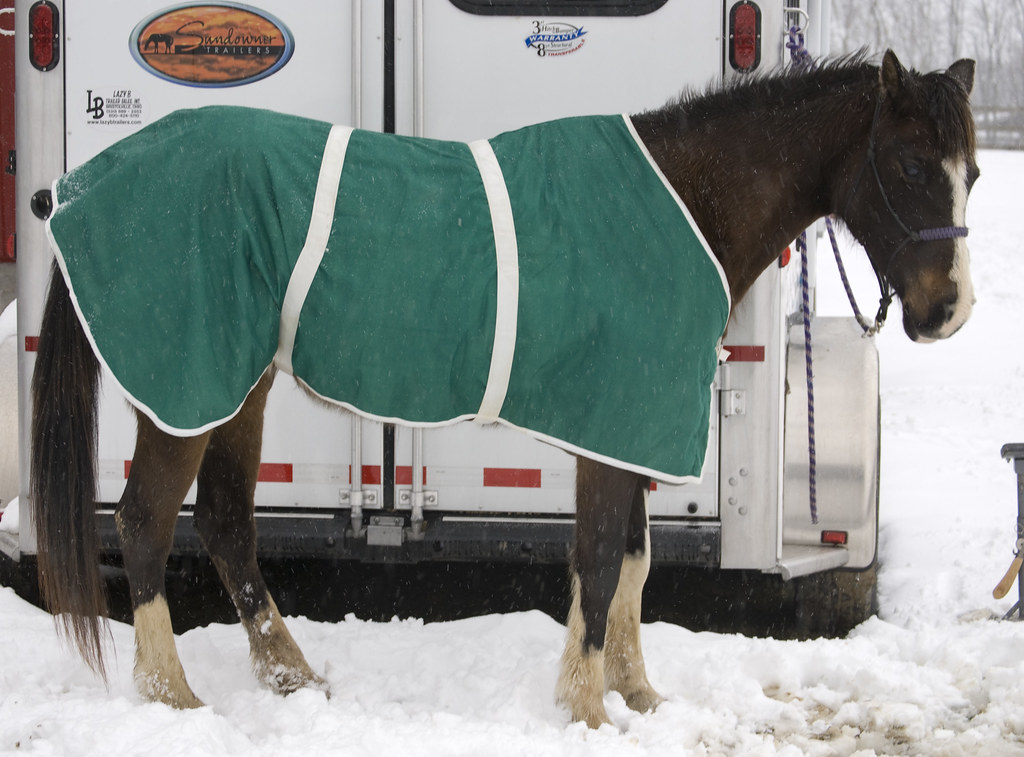 |
| She doesn't stand uncomfortably |
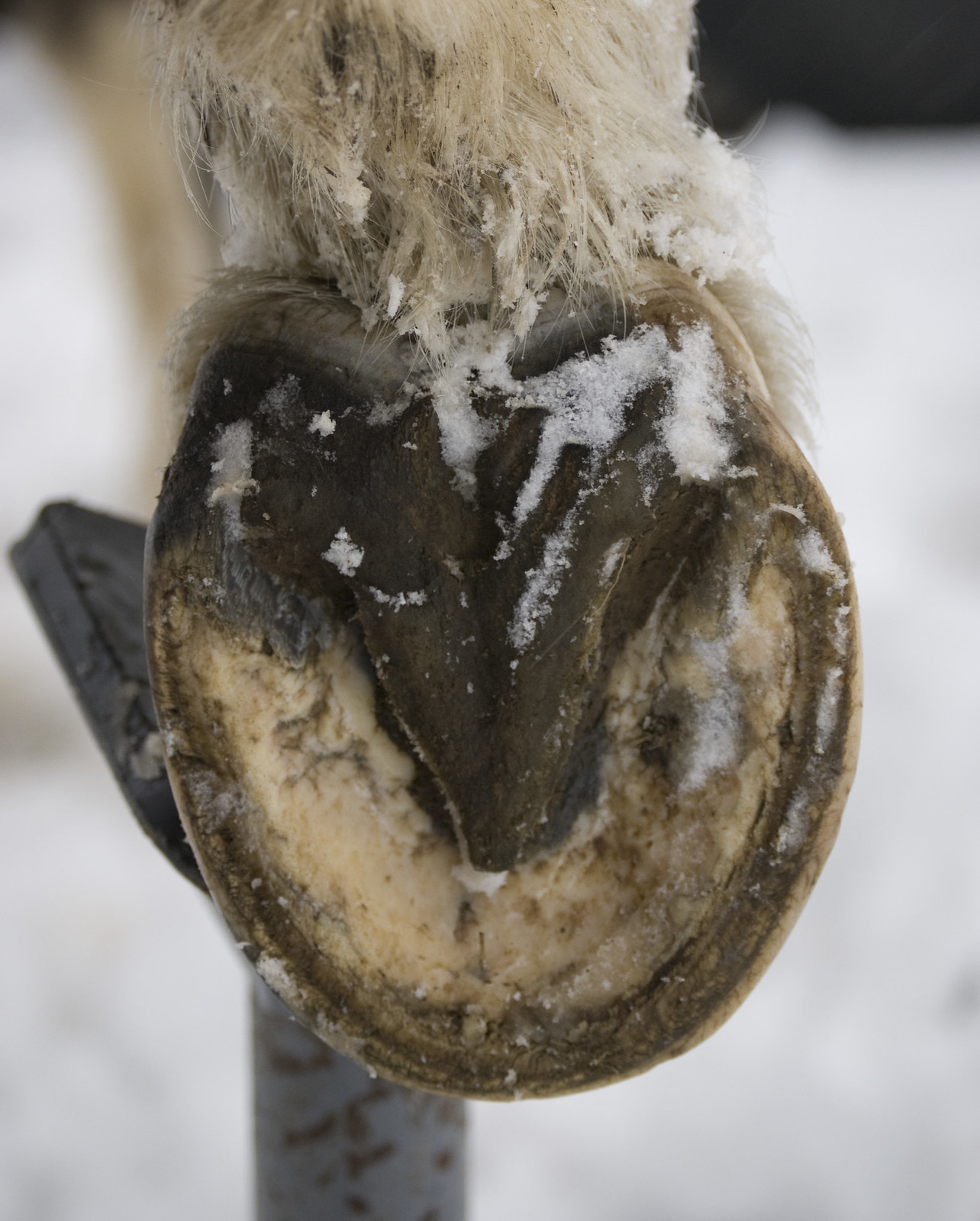 |
| Right hind |
 |
| Left hind - trend on all feet seems to be that she lands left-sided....? |
Conclusion? I need to see how comfortably she moves in boots/boots with pads. It kills me to see her move like she does, but while tender, she doesn't seem miserable. She's still willing to play in the field with the others and move out - fast. Time is my friend, so we'll see how she feels in upcoming days and weeks!
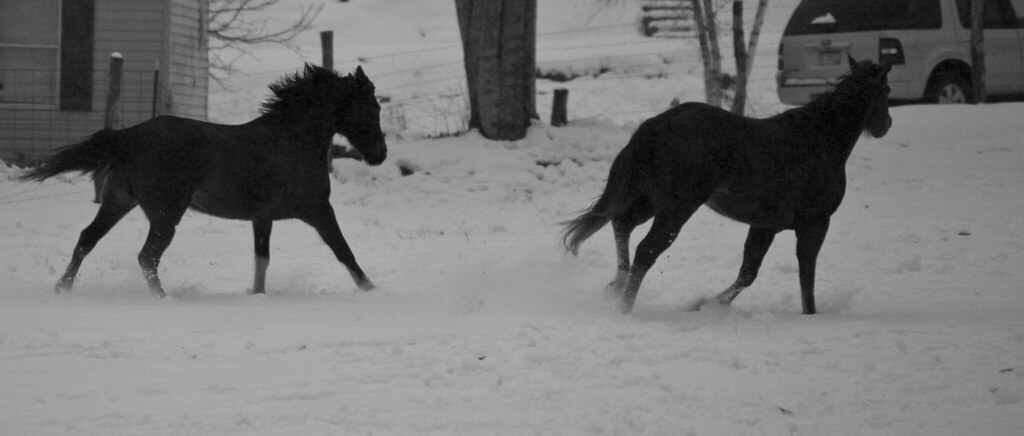 |
| Q on the left, clearly not feeling too bad |
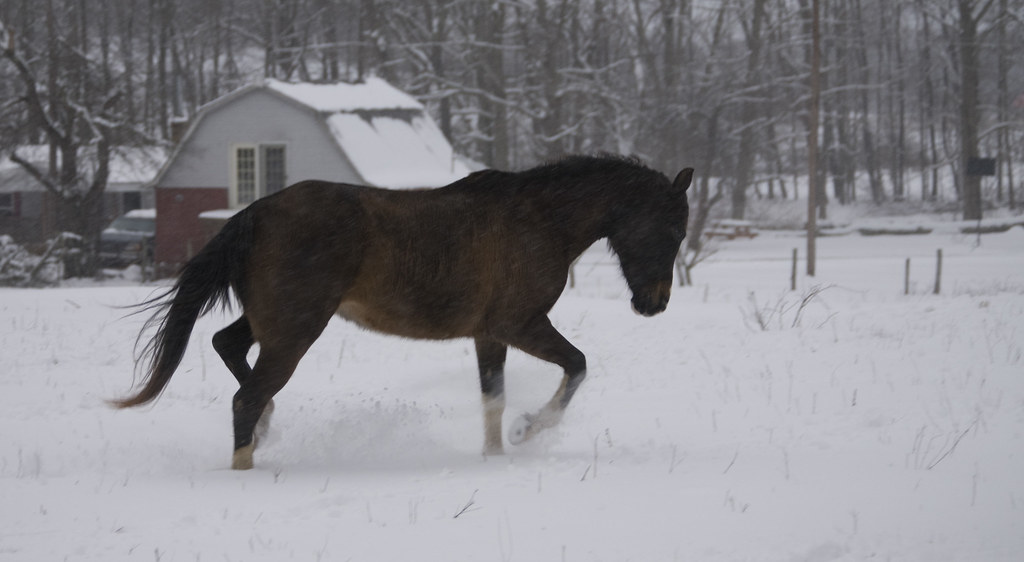 |
| Mid head-toss. Sassypants. |

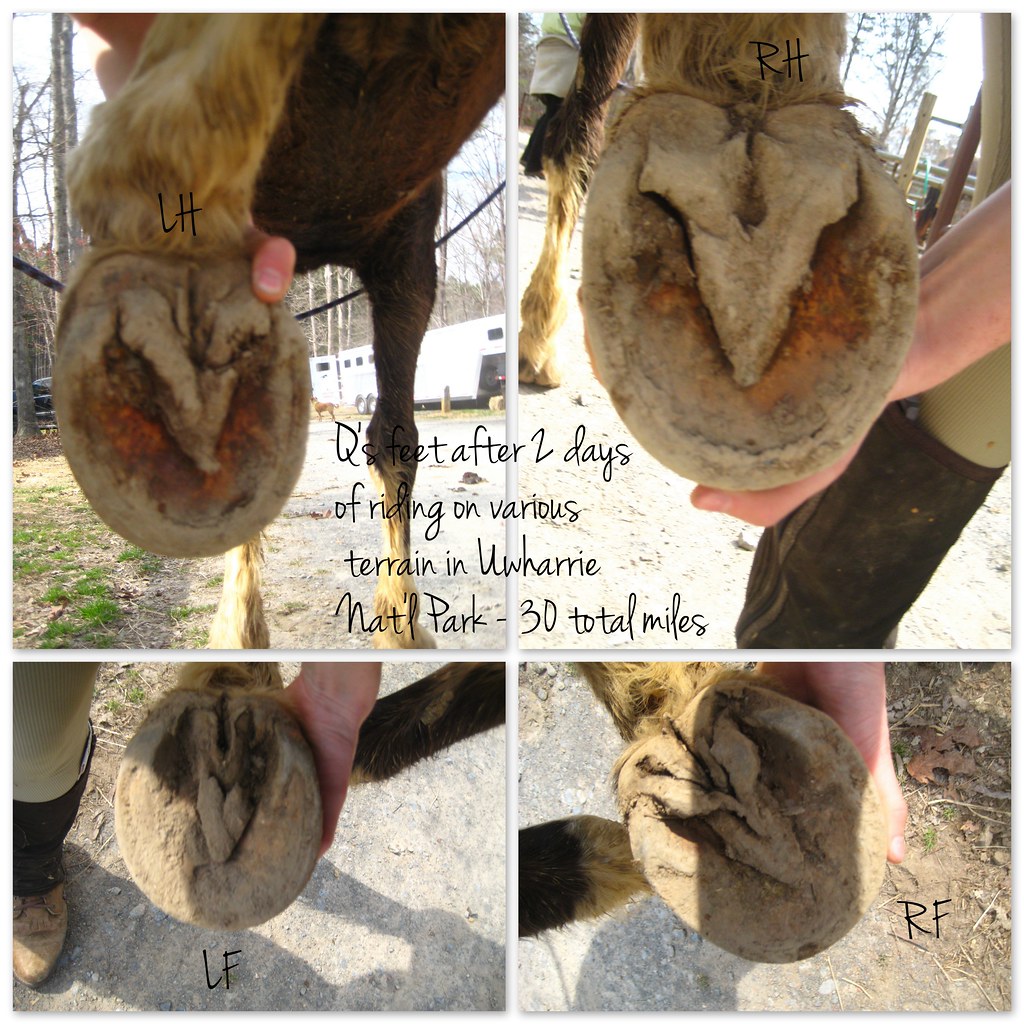
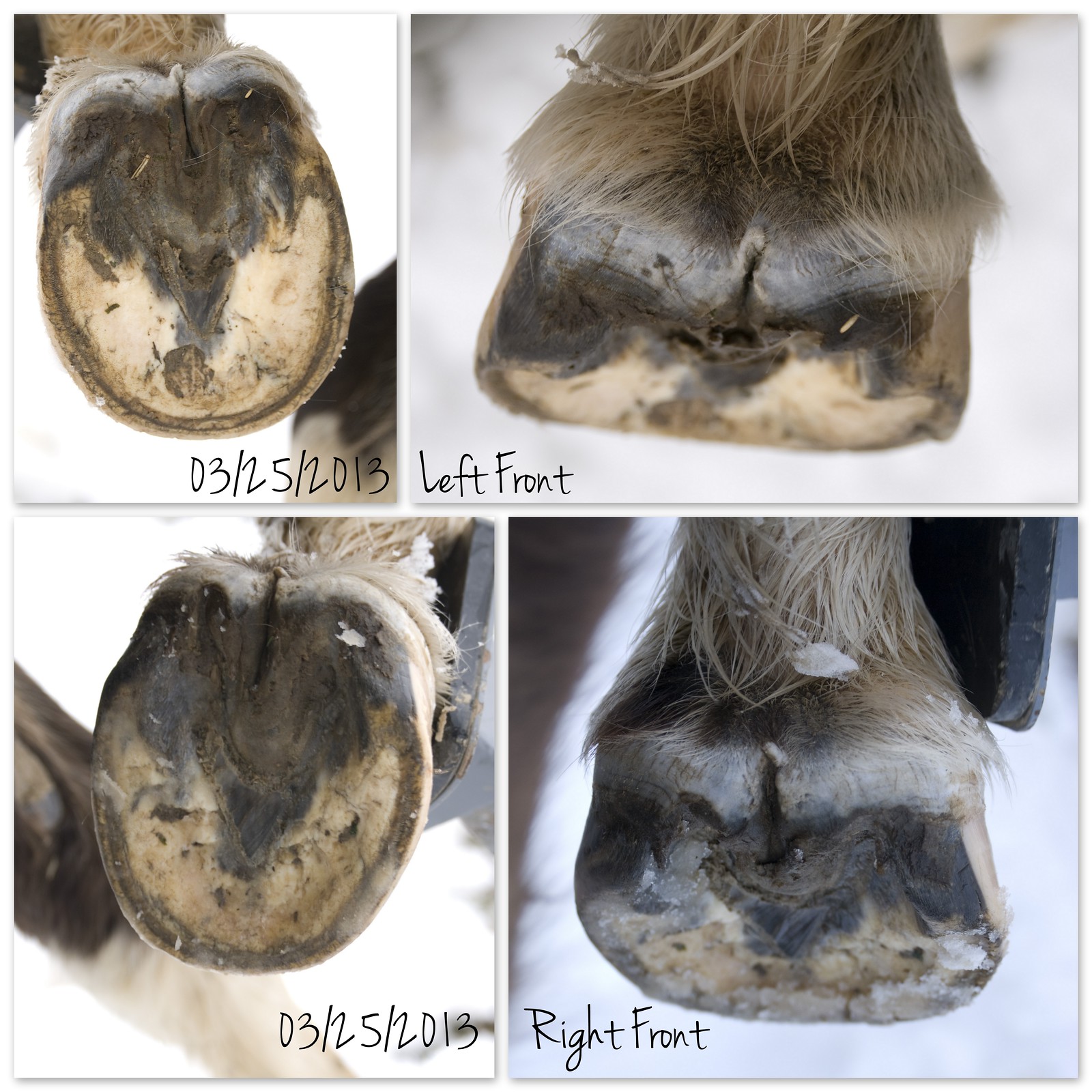
THIS!! This was SO helpful to me! I had wondered about concavity-Lily's hooves had started developing it in FL towards the end, then disappeared here, completely. I'm glad to know it's due to the harder terrain. My trimmer in FL also STRONGLY recommended boots-she was the one that measured Lily for the Cavallos.
ReplyDeleteI would say about 50% of the time when I lunge Lily prior to riding, it's just to see how she's moving. I just never admit that on the blog. ;)
It's amazing how the frogs on Q's fronts seem to almost be starting back up from scratch-that's some impressive shedding. I think I would have been a little disconcerted myself! Lily's have started shedding too-we'll see how they turn out.
What a good girl Q is, standing still for her White Lightning treatment! :)
Have you tried Durasole to accelerate hardening? I've had 2 farriers and 2 trimmers recommend it. It is only $11-$12 a bottle, and one bottle with 3x week applications will last you about a month and a half. (I get mine from Jeffers Equine.) I've been using this stuff religiously on Lily since she initially went barefoot. In the beginning, whenever she had a sore day, I'd apply this daily for the next 2-3 days, and the soreness disappeared. With the constantly changing moisture levels and conditions in the ground here, I've been applying it diligently about 4 days a week average. My current trimmer actually favors it over Keratexx.
I hope she's all better real soon!
I'm really happy it could help someone! Thanks for the tip on another product! I'm happy to report that she's sound in boots =) Checked her Tuesday and she was a lot less gimpy and sound with front boots. Huzzah!
DeleteAwesomeness!!
Delete